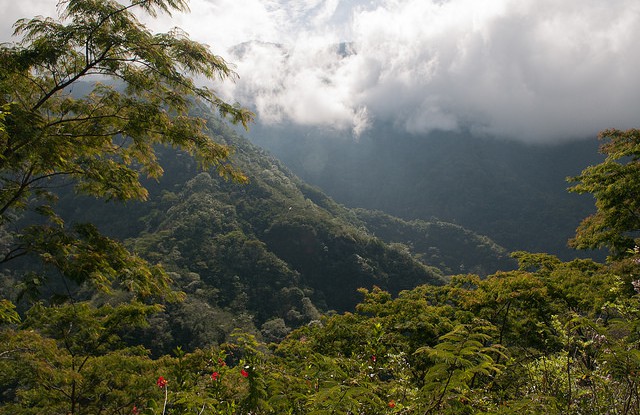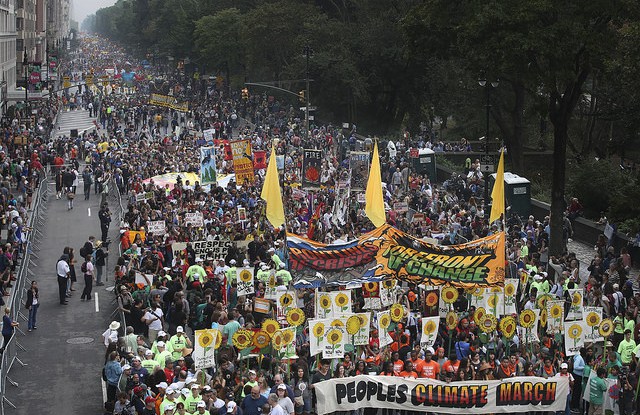
NEW YORK—For forests, it was a historic moment.
The New York Declaration on Forests, signed last week at the UN Climate Summit, was notable not just for its ambition—halving deforestation by 2020 and ending it by 2030—but also for its broad-based support from governments, corporations and indigenous groups.
History will show whether the pact can actually deliver, said experts who lauded the aims of the declaration but expressed concerns about some of its limitations.
“This broad support is really something good that has come from Climate Week,” said Peter Holmgren, Director General of the Center for International Forestry Research (CIFOR). “It is not every year that we have heads of states gathered and you hear them speak about forests, agriculture and commitments.”
“And private corporations are making moves in the direction that many of us think is a good direction: to bring in climate change into their value chains and to see it as a business opportunity.”
More than 30 countries as well as 30 corporations signed the declaration, including Golden Agri-Resources, Cargill, Asia Pulp and Paper, McDonald’s, Nestle and Kellogg’s.
“The objective to try and eliminate deforestation, to engage with the private sector is new and useful, and I think that’s one of the things that we’ve seen here throughout the climate week in New York,” said Louis Verchot, Director of Forests and Environment Research at CIFOR. “The private sector engagement is at a much higher level than it has been in the past.”
BRAZIL BALKS
Regarding the country signatories to the Declaration, there was one notable absence.
The declaration is a little bit short in that it focuses on forests as an entity and not on forests as an entity within the landscape
Brazil’s refusal to sign the declaration stood in contrast to its progress in curbing deforestation. In the past 10 years, Brazil has reduced its deforestation by nearly 80 percent, though 2013 saw a small rise in deforested land.
“Brazil did not sign for diplomatic and, let’s say, legal restrictions, because it said ‘zero deforestation,’ and Brazilian law today allows for a certain small amount of deforestation,” explained Carlos Nobre, the National Secretary for Research and Development Policy in Brazil’s Ministry of Science, Technology & Innovation. “However, Brazil is intent to get to zero deforestation soon.”
CUTTING CARBON, ABSORBING CARBON
If successful, the declaration would have far-reaching effects not just on forests but on the climate: Carbon emissions caused by deforestation could be cut by 4.5 billion to 8.8 billion tons per year—roughly the yearly emissions of the United States. Forests also play a safety-net role in the current climate system, absorbing up to 45 percent of carbon emissions.
In addition to being effective carbon sinks, forests play key roles in landscapes to support agricultural productivity through ecosystem services such as pollination, water quality maintenance, groundwater recharge, and maintenance of soil quality. It is estimated that about 1.6 billion people living in and around forests are heavily dependent on these forests for their livelihoods.
SOME CONCERNS REMAIN
Despite the praise for the declaration, there are some concerns as to its approach.
“The UN declaration goes a long way in recognizing forests as a major target for conservation and for climate change mitigation in the coming 10 years and 20 years,” said Eduardo Brondízio, Professor of Anthropology and Adjunct Professor of Environmental Sciences and Geography at Indiana University. “On the other hand, it seems to just put forests on the conservation side more than on the management side.”
Some experts also expressed concern that the declaration isolates forests, separating them from their interconnected roles with other land uses.
“The declaration is a little bit short in that it focuses on forests as an entity and not on forests as an entity within the landscape,” Verchot said. “Agriculture, forestry and land use would have been a really nice declaration.”
“Agriculture causes 80 percent of deforestation in the tropics and is the leading cause of biodiversity loss,” he continued. But it is also crucial to human subsistence—in Africa alone, he said, agriculture provides subsistence and livelihoods for 80 percent of the continent’s population.
Forests, meanwhile, “provide all kinds of ecosystem services including those that support agriculture, food security and balanced nutrition,” Verchot said. “Thus dealing with forests and agriculture separately does not make sense. Both land-use systems are essential for human wellbeing, and there are tradeoffs between the two land uses that need to be recognized and managed.”
CIFOR’s Holmgren agreed.
“There are surprisingly few cross references between the forest declaration and the agriculture declaration, and the institutional arrangements for these two sectors remain apart,” he said.
“This really limits our options. We have a much better chance of finding solutions if we look across the sectors.”
We want you to share Forests News content, which is licensed under Creative Commons Attribution-NonCommercial-ShareAlike 4.0 International (CC BY-NC-SA 4.0). This means you are free to redistribute our material for non-commercial purposes. All we ask is that you give Forests News appropriate credit and link to the original Forests News content, indicate if changes were made, and distribute your contributions under the same Creative Commons license. You must notify Forests News if you repost, reprint or reuse our materials by contacting forestsnews@cifor-icraf.org.

